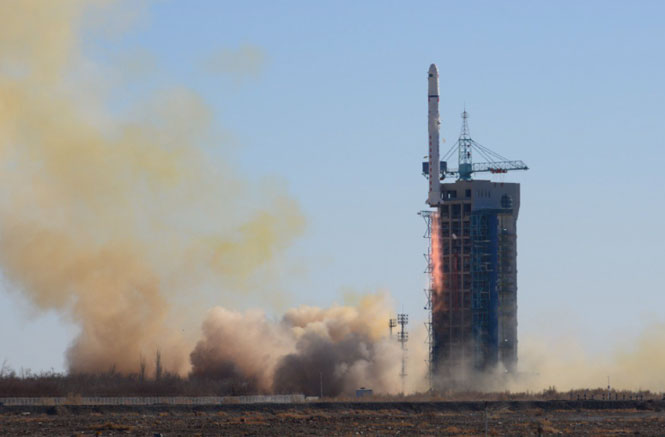China takes advantage of garbage satellites as AI weapons
Small satellites, which weigh less than 10kg, can turn into weapons to attack non-cooperative targets such as spacecraft drifting in orbit near Earth.
The 3-eye sensor system will help them measure the shape, relative speed and random rotation status of the target, and the 1-axis robot arm will reach the target when the distance is within 20cm.
The satellites will then shoot and drive the target so that they are burned while plunging into the atmosphere.
In the military context, satellites can cling to cosmic garbage to avoid being monitored from the ground.

A 2D Truong Chinh missile was launched into orbit from northwest China in December last year.(Photo: Xinhua).
In the past decade, China has tested at least 10 satellites to test this application, but not the only one to do so. The European Space Agency launched at least two satellites to find a way to 'catch' a garbage object in orbit with various methods, such as net fins. And the US military is also believed to be developing technology to use garbage to hide tactics for smaller satellites in the context of cosmic warfare.
Luo Jianjun, deputy director of the National Flight Technology Laboratory in Xi'an, Shaanxi Province, confirmed that China has this program.
Recently, the program was partially declassified, but Luo said most of the details were kept secret because of the possibility of military applications."We don't want to talk about it publicly ," Luo said.
China's first space laboratory, Heaven Palace-1, was out of control last year, raising concerns about the possibility of it falling to Earth. But it eventually burned safely on the southern Pacific Ocean - the traditional grave of cosmic objects.
Luo said pushing such a garbage object from orbit may be an application of technology that takes advantage of old satellites, but the program is still in an experimental phase and has not yet been deployed on a large scale.
According to a document declassified by the Chinese government in January this year, the country began experimenting with technology to utilize old satellites since 2008.
'This project not only finds applications for more than 10 satellite models . but also in unmanned aircraft, smart weapons and robots' , the document said, but did not say specifically.
Mr. Chen Songlin, an aerospace scientist at Harbin Institute of Technology, Heilongjiang Province, technology to utilize old satellites seems easy but causes many challenges.
If the target is too big, the rotation force can damage the satellite's arm, Chen said. He also argued that that was the reason the arm had only one joint, in exchange for free movement for power.
Getting the object rotating randomly can be harder than clinging to an active satellite.'It requires very good algorithms and clever hardware to predict and decide when to snatch,' said Mr. Chen.
Currently, the old Chinese satellites can only catch garbage objects rotating less than 3.2 degrees per second, the document said.
This program is being led by Mr. Liu Fucheng, Director of Shanghai Space Control Technology Institute, a branch of China Space Science and Technology Group. The group is responsible for developing control, navigation and guidance systems for tactical, missile and satellite technologies.
In an article published in a Chinese research journal in 2015, Mr. Liu and his colleagues proposed to use large-scale spy or communication satellites on high-altitude geography, taking some photos and withdrawing to avoid being caught.
However, a senior astronomer works at the Yunnan Observatory in Kunming, one of the ground facilities responsible for monitoring and classifying space and satellite to serve operations. of the Chinese military and intelligence, argued that the unusual movement of small artificial satellites could be detected by a sensitive microwave radar network and optical telescope.
'Sunlight reflected from the goal has also provided a lot of information, ' said the unnamed researcher.
All missile launches are closely watched by countries and satellites are carefully recorded.
'But this system is not perfect. If several dozen cube satellites are launched at the same time, some of the satellites can escape the radar coverage. If they are attached to cosmic garbage, they will never be detected , 'said the researcher.
- China takes two satellites to lead North Road 3 into space
- Save the Earth with laser satellites?
- 'Overload' cosmic garbage
- China will soon surpass Russia in the number of satellites operating in orbit
- Machine to clean up space
- Hong Kong charged the garbage tax
- China launched 12 meteorological satellites before 2020
- Potential risk from 'cosmic garbage'
- Headache of satellite security
- The United States and France are also tracking cosmic garbage
- China built the world's largest garbage power plant
- Accurate fall point of German satellites
 Van Allen's belt and evidence that the Apollo 11 mission to the Moon was myth
Van Allen's belt and evidence that the Apollo 11 mission to the Moon was myth The levels of civilization in the universe (Kardashev scale)
The levels of civilization in the universe (Kardashev scale) Today Mars, the sun and the Earth are aligned
Today Mars, the sun and the Earth are aligned The Amazon owner announced a secret plan to build a space base for thousands of people
The Amazon owner announced a secret plan to build a space base for thousands of people